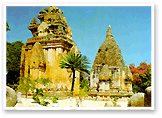Thap Ba (Tour de Ponagar)
Thap Ba (Tour de Ponagar) |
Il s'agit de l'ensemble de vestiges historiques, d'ouvrages typiques de l'architecture et de la sculpture des Cham. La tour de Ponagar est le nom commun du secteur de vestige, mais elle désigne vraiment le nom d'une tour la plus grande parmi les 4 tours de ce genre de vestige. La tour se trouve sur une petite colline ou le mont Thap Ba, à côté de la route nationale 1A, relevant du quartier de Vinh Phuoc, au nord de la ville de Nha Trang.
 Ces tours Cham ont été érigées et restaurées entre VIIe et XIIe siècles.
Les plus belles datent de 813 à 817. Aujourd'hui, il n'en reste que quatre, chacune
dédiée à un dieu.
Ces tours Cham ont été érigées et restaurées entre VIIe et XIIe siècles.
Les plus belles datent de 813 à 817. Aujourd'hui, il n'en reste que quatre, chacune
dédiée à un dieu.
Une tour est dédiée au culte de Shiva, élément de la Trinité suprême de l'hindouisme. Une autre honore son fils Garesha, au corps d'un homme mais à la tête d'éléphant. la dernière qui est aussi la plus grande, achevée en 817, haute de 23m est consacrée au culte de Ponagar, la Déesse qui a enseigné la riziculture à la population. Elle est construite en briques cuites, étroitement agencées pour constituer un quadrilatère. le sommet est de forme pyramidale. le portrait de Shiva à quatre mains, se tenant à califourchon sur le taureau Nandi est gravé sur la porte de la tour. L'extérieur est marqué par un ouvrage sculptural aux bas - reliefs délicats alternés des lignes intentionnellement maladroites, représentant les Apsaras (Déesses - danseuses) ainsi que les activités de la vie quotidienne: rame, décortiquage du riz, tir à l'arc.
La tour donne sur une cour dallée rectangulaire où s'élèvent deux rangées de colonnes au sommet octogonal. La cour aurait du servir de lieu de culte et d'offrandes en l'honneur de la déesse. La colline offre aujourd'hui une vue magnifique des alentours, juste au pied de la colline coule la rivière Bong, les maisons et pagodes du village Con se côtoient...Au loin apparait en mer le promontoire de Hon Chong.